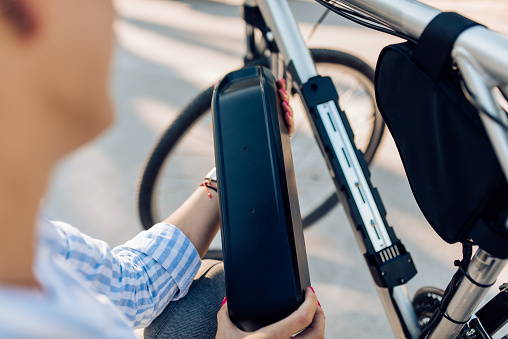
Summer Weather Tips for Your Electric Bike Battery
If you are considering an electric bike, one of the most important factors to consider is the battery. Electric bike batteries come in various shapes, sizes, and types, and each has its own advantages and disadvantages.
There are two main types of electric bike batteries: lead-acid and lithium-ion.
Lead-acid batteries are the oldest type of battery and are typically found on cheaper electric bikes. They are heavier than lithium-ion batteries but can be cheaper to replace.
Lithium-ion batteries are the newest type of battery and are typically found on more expensive electric bikes. They are lighter than lead-acid batteries and can hold a charge for longer. However, they are more expensive to replace.
No matter what type of battery you choose, make sure to keep it charged and maintained. Electric bike batteries are expensive, and replacing one can be a hassle. With proper care, your battery will last for many years.
Get $50 off your first order
Sign up for special offers and updates
Ideal Conditions for Electric Bike Battery Storage, Usage, & Charging

Electric bikes are a great way to get around, but they need to be properly cared for in order to function correctly. One of the most important aspects of caring for an electric bike is making sure the battery is properly stored, used, and charged.
Below, I have discussed the ideal conditions for storing, charging, and using an electric bike battery.
1. Ideal Storage Conditions
There are different ways to store your electric bike, such as standing, hanging with a bike stand, and vertically mounted. But when it comes to storing your Ebike’s battery, first detach it from the bike. Because temperature & climate change can damage the battery contacts.
It is recommended to remove the battery from the bike for proper storage. Additionally, it is also recommended that you should store the battery when it is fully charged or discharged.
Furthermore, temperature plays a crucial role in battery storage as it directly affects the performance of the battery. If you store the battery in warmer conditions, it will discharge quickly and require more charging often.
So, the best place to store an electric bike battery is in cool conditions where its internal resistance is at its highest levels and will last longer.
However, if you want to store Ebike outside, then make sure you have got a cover for it. A cover will not only prevent the battery from damage but also keep the rust & dust away from the bike.
2. Ideal Usage Conditions
Electric bike batteries are typically designed to provide power for a specific number of charge and discharge cycles. The ideal usage condition for an electric bike battery is to charge and discharge it within its specified cycle life.
When an electric bike battery is not used within its ideal usage condition, its performance will degrade over time. The ideal usage condition for an electric bike battery is to be charged and discharged at a moderate temperature, between 10-30 degrees Celsius.
3. Ideal Charging Conditions
The ideal charging conditions for an electric bike battery include cool temperature and slow charging. According to experts, charging at a temperature between 5-45 degrees Celsius is good. Additionally, you shouldn’t charge your battery in low-temperature conditions.
Tip: Try to keep your battery charged between 40% and 80%. This is the ideal range for lithium-ion batteries.
Danger Zones To Avoid:

As the weather gets warmer, more and more people are dusting off their bicycles and taking them out for a spin. However, if you have an electric bike, there are a few extra things you need to avoid before hitting the road. Here are a few dangers to avoid when it comes to your electric bike battery:
1. Overheating:
Just like any other type of battery, overheating is a real danger for electric bike batteries. When the temperature gets too high, the battery cells can start to break down, which can lead to a fire. If you're going to be riding in hot weather, make sure to keep an eye on your battery temperature and stop for a break if it starts to get too hot.
2. Overcharging
Another danger to avoid is overcharging your battery. This can happen if you leave your bike plugged in for too long or if you try to charge it faster than it can handle. Overcharging can damage the battery cells and shorten the overall life of the battery.
3. Deep discharge
Deep discharge is when the battery is completely drained of power. This can happen if you forget to charge your battery after a long ride or if you ride in extremely cold weather. Deep discharge can damage the battery cells and make it difficult to recharge the battery.
4. Physical Damage
Finally, physical damage is also a danger to avoid when it comes to electric bike batteries. If the battery is dropped or smashed, the cells can break and leak, which can cause a fire. It's important to handle your battery carefully and keep it in a safe place when you're not using it.
By following these simple tips, you can help keep your electric bike battery safe and avoid any potential dangers.
What to do if the battery is too hot & Catches Fire

If your e-bike's battery is too hot and catches fire, the first thing to do is to disconnect the battery from the bike. Once the battery is disconnected, do not attempt to re-connect it or to use it in any way.
Next, take the battery outside and away from any flammable materials. If the battery is still hot, do not touch it with your bare hands. Place the battery on a fire-resistant surface and allow it to cool down. Once the battery is cool, inspect it for damage. If it’s damaged, it will need to be replaced with a new one.
However, be sure to dispose of the damaged battery properly. Do not attempt to repair or reuse the damaged battery.
If you or anyone else was injured in the fire, seek medical attention immediately.
Frequently Asked Questions

Can I do anything to prevent my battery from overheating?
Yes, there are a few things you can do to prevent your battery from overheating. First, try to keep your battery out of direct sunlight as much as possible.
Second, if you're not using your bike regularly, make sure to give it a full charge at least once a month.
Finally, if you live in a particularly hot climate, you may want to consider investing in a battery cooling system.
How can to tell if battery is getting too hot?
One way to tell if your battery is getting too hot is to touch it. If it feels hot to the touch, it's probably best to avoid using it until it cools down.
Another way to tell is if the battery is giving off an abnormal odor. This can be a sign that the battery is overcharging or overheating.
What are some signs that my battery needs to be replaced?
Here are a few signs that your e-bike battery may need to be replaced:
Reduced range: If you notice that your e-bike’s range is reduced, it may be time for a new battery.
Increased charging time: If it takes longer to charge your e-bike battery than it used to, that’s a sign that the battery is losing capacity.
Diminished performance: If you notice that your e-bike isn’t performing as well as it used to, it may be time for a new battery.
Swelling battery pack: If you notice that your battery pack is swelling, it’s a sign that the battery is damaged and needs to be replaced.
How often should I replace my e-bike battery?
This depends on a number of factors, including how often you use your e-bike and how well you take care of the battery. In general, you can expect to replace your e-bike battery every few years.
Should I avoid riding my electric bike in hot weather?
Not necessarily. Just be sure to keep an eye on your battery level and take breaks often to let the battery cool down. It’s also a good idea to avoid hills or other strenuous ridings that will tax the battery more than usual.
Final Words:
Summer weather can be tough on your electric bike battery. However, by following a few simple tips, you can help extend the life of your battery and keep it running at its best.

